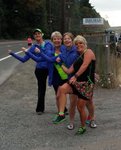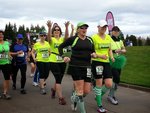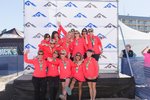


Life is a marathon and not a sprint for the women of Untethered Soles race walking group.
The Portland metro-based group has members from Clark County among other parts of the region, and if last month’s competition in one of the largest relay races in the world is any indication, they’re a top-notch team for their age bracket.
The team placed first in the 2017 Portland to Coast walk relay for the Women’s Champion Masters category, which features teams made up of women whose average age is 60 or above. Although the team had strong showings in past years, this was the first No. 1 standing in the competition.
Moving up a category coincided with their first-place success, though captain Jill Bolm said that even if they were back in the “Super Masters” category for women over 50, they would have placed second. Overall, they placed 23rd out of 400 teams, their highest overall placement since starting in 2011.
That said, 2017 was the year it all seemed to work.
“Everybody got out of the van and just did their best and outperformed the times I had estimated,” Bolm said.
Although many of the team members take part in solo competitions year-round, it is the big Portland to Coast excursion that brings the team together every year. The walk relay is one of a few different events that are part of the larger Hood to Coast brand, including a running relay going from Mount Hood to the endpoint for all of the races in Seaside, Oregon.
Bolm said the group started up as a result of a post in a church bulletin that brought the team together. She has participated with the team ever since, except for one year when she was out with foot surgery.
One of the defining characteristics of Untethered Soles is their focus on camaraderie among teammates, Bolm explained.
“There’s a lot of teams that are super-competitive and the people just don’t have any fun,” Bolm said. “We’re a definite ‘no drama zone’ team. We have fun or we don’t do it.”
After forming six years ago, many of the team members forged strong friendships that keep the team happy.
“We do life together,” Bolm said.
“It’s really as much social as it is keeping us active,” Bolm added. “We talk about that all the time. If we quit doing this, what would we do?”
Walking versus running
Apart from what appears to be a slower pace, the mechanics of race walking differ from the more conventional running races. Bolm explained the two chief rules for the competition: One foot always has to be in connection to the ground and a leading leg must remain straight as it passes under the torso, resulting in a particular gait.
“It’s much easier to run than it is to race walk,” Bolm said, “but it’s a little easier on your body than running. You’re not beating up on your knees and stuff so bad.”
“I think younger people think they have to be runners to be an ‘athlete,’” Bolm wrote in an email following her interview. “We enter lots of 5K/10K and half-marathons where we pass runners all the time. Nothing ticks them off more than to be passed by ‘a walker.’”
“People just don't understand that this is more than a stroll down the street,” Bolm remarked.